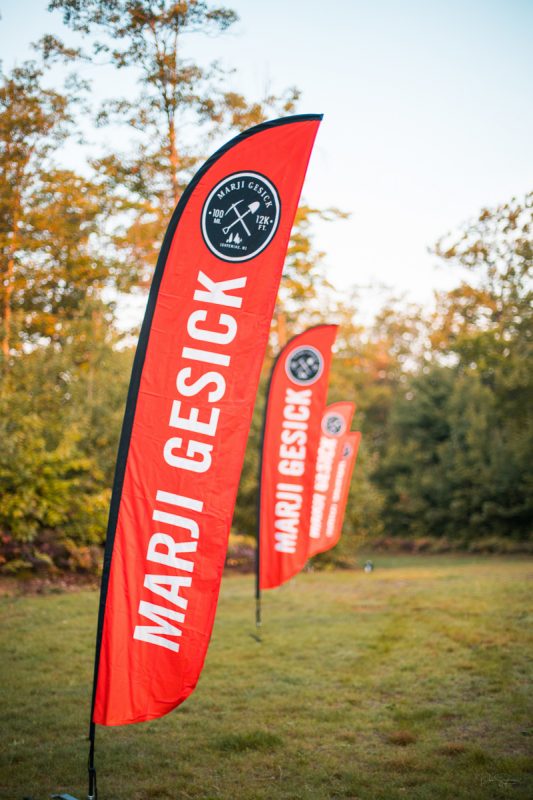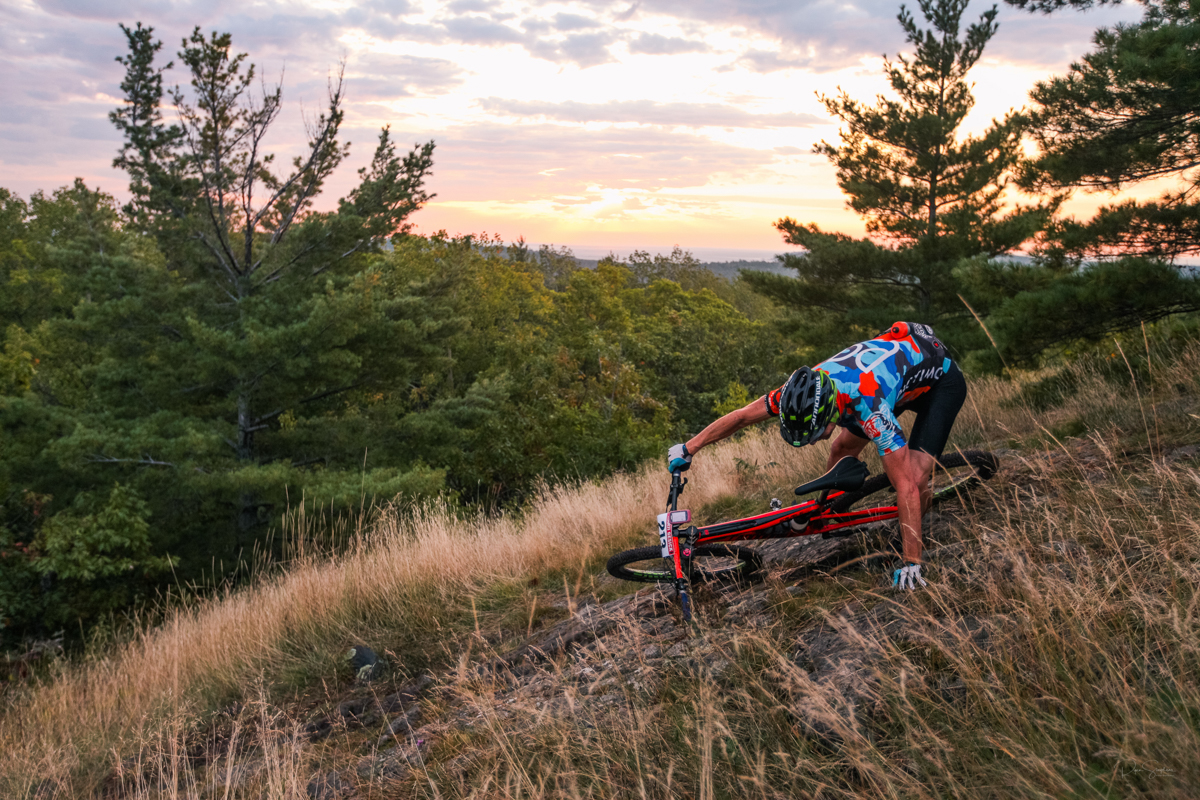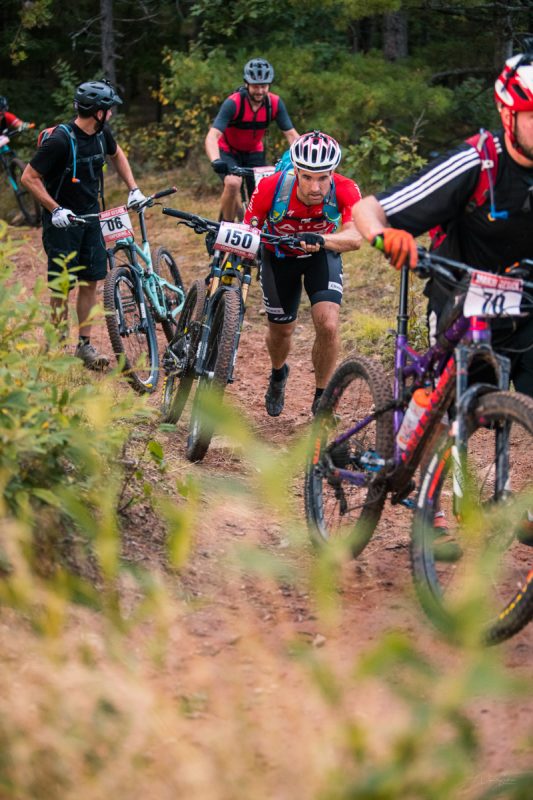Mountain Bike Trailer Park: Five steps to MTB failure
Originally posted on October 6, 2017 at 1:00 amMountain Bike Trailer Park is a regular column written by Uncle Dan that appears monthly on the Dirt Rag Interwebs. He dabbles in a variety of topics including racing, training, trails he loves and not taking himself too seriously, all with a big dash of humor. If you missed his previous columns, check them out here. He also writes a personal blog, which can be found here.

They say that we learn more from our failures than our successes. If that’s true, then I should be an expert at mountain bike racing. Or at least an expert at failing at mountain bike racing.
The secret to success at failing can be boiled down to five central principles. To illustrate these principles, I offer a case study of my most recent race – the Marji Gesick 50 (57) in Marquette, Michigan.

Without further ado, let’s dive straight in.
Step One: Plan ahead for failure.
Three weeks before the race, cut down on sleeping and training.
Failure doesn’t just happen, you have to plan for it! My plan starts three weeks before race day. I call this period the “failure taper.”
Just quit training. You can ride some, if you want, just make sure that it is completely unstructured and that each ride is either too hard or too easy.
And as long as you’re not training, try to find a good series on Netflix to binge watch. Go ahead and stay up too late every night watching every episode. And when you wake up on the couch at 2:30 am, with a chest covered in potato chip crumbs, and Netflix asks “Are you still watching?” rub the sleep out of your eyes and answer “yes.” “Yes I am.”
Step Two: Dehydrate, dehydrate, dehydrate.
Beer is your friend.

Drink a six pack the night before a race. It doesn’t matter what kind of beer, but cans are preferable. They pack easier.
My local go-to is North High Pale Ale, but, being in Michigan, I had to sample the local offerings – so many good breweries in Michigan!

For long races, it’s important that you hydrate. And carb load. Beer has water and carbs. Seems like a recipe for success, right?
Wrong! That much beer will actually help you meet your failure goals by pre-dehydrating you. So, less to worry about not drinking on race morning!
And remember to keep dehydrating during the race. Pack a beer in your drop bag to drink it mid-race. Should be nice and warm by then.
Plus, beer has added performance-diminishing qualities. Alcohol messes up your metabolic system during exercise. It forces your kidneys into dealing with the alcohol before processing anything else. Double whammy!

And you might as well also pack a two-day old gas station chalupa in your drop bag too. Because, you know, it will taste good with the beer. Unrefrigerated gas station roller food will definitely help you meet your gastrointestinal goals of not meeting your nutrition needs during the race.
Step Three: “It’s probably fine.”
Do not check your bike or equipment before the race.
Don’t check your tires, lube your chain, or air up the suspension. You rode recently, right? It’s probably fine.

Also, don’t clean your camelback. In fact, don’t even empty it from the last race. It’s probably fine.

That fancy sport drink mix you use is expensive. So, if you have some leftover from your last ride, just throw that half-full bladder in the freezer when you get home. Doesn’t matter that it’s been on your back and in a hot car all day. That will probably be fine.
Defrost it at least 48 hours in advance of the race, and put it back in your hot car for the two-day trip to the race. On race day, just throw some more powder in the bladder and top off with water, preferably warm, and from the hotel bathtub. Probably fine!
I tried this recipe on the Marji Gesick. It produced a nice, fermented batch of energy drink that had hints of vanilla, cucumber, and sour goat milk.
It will be drinkable, if you don’t mind gagging and stomach pain. Since you have 21 miles in humid 80 degree weather, and nothing to drink, you should be able to start cramping well before your competitors! You’ve now entered the pre-bonk!
Step Four: Underestimate the race.
Don’t listen to the race directors. It’s probably just hype!
The Marji Gesick is, by design, a race for masochists. I should have known by all the marketing about the race. And the 50-70% drop rate. And the pre-race instruction email which was titled “you poor bastards.” Oh, and I definitely should have taken notice when the Grim Reaper showed up to start the race.

In fact, the race is so tough that the motto is “Blame Danny, Blame Todd” (the course designer and race director). On the course, whenever you saw a sign stapled to a tree that said “Blame Danny,” you could be sure there was some crazy shit coming up fast.

But, go ahead and ignore all of this, Be confident that it’s just marketing hype. Like me, you will rest easy, knowing that you have already done four 100-mile races this year. What’s another 54? (The race has 105 and 54 mile options. I chose the 54, because it would be “easier.”)

Now that you’ve underestimated the race, make sure you go out too hot. This is only a 54-mile race, right? So, you should be able to push waaaaaay harder for the first 40 miles than you normally would on a longer race.
It’s really a three-step process: (1) go out too fast; (2) slow down; and then (3) blow up completely and soft pedal/walk the remainder. On the Marji Gesick, I followed these steps. I finished the first 20 miles in 2:35, the next 20 in 3:40, and the final 16 in 4:24. Perfect!

(It didn’t help that I had bet my 16-year-old teammate Mikey $10 that he couldn’t beat me. He used my $10 to buy coney dogs and fries)
Step Five: Suffer.
When you’re suffering, don’t quit the race. Never quit the race.
If you follow steps one through four above, you should suffer a crack, aka bonk, aka blow up. The crack, which I have previously written about, is a glycemic and/or hydration deficit that tells your body to stop putting in effort immediately, and sends your psyche into a downward spiral.

If it’s bad enough, you may have a headache, stomach distress, dizziness, crying, and possibly even pass out.
Now, a lot of people would quit under these circumstances. They think that it’s not safe to continue riding if you’re suffering dizzy spells or sobbing uncontrollably. They’re probably right.
Why keep pushing yourself? There’s no trophy or prize money waiting for you at the finish, no bards will sing tales of your heroic efforts. Frankly, no one but you (and maybe Todd) cares whether you finish or not.

But, under my plan, you will not drop out. You will continue to suffer. Listen to all those people who will ride by and offer friendly encouragement. They’ll tell you to “just keep going.” And “pain is temporary, quitting is forever.” Who cares that you might pass out? The important thing is that you suffer all the way to the end.

Secret Step Six: Wake up the next day and reflect on what you did.
This race is a killer. I can’t stop thinking about it. Despite all my failings, I finished – which is more than half the starters can say. And, I even kind of finished mid-pack.

In reflection, maybe I can call my failure a success. But I still have, as Todd says, “unfinished business” on the course. I’ll be back next year. And maybe I’ll skip a couple steps.

Got it? Good. Now, go forth and fail!
Be brave and succeed at failing.